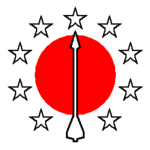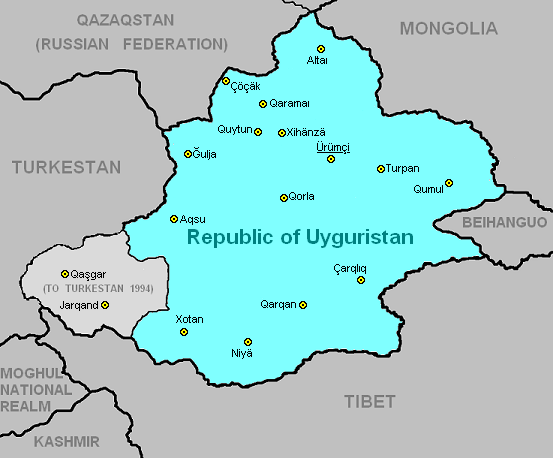Uyguristan

| |
| National motto: | |
| Languages | |
| Official | Uygur |
| Other | Putuņhua (Mandarin Chinese), Qazaq, Kırğız, Tajik, Tocharian, Mongolian |
| Capital | Ürümçi |
| Important Cities | Xotan, Turpan, Ğulja, Aqsu, Kuqar, Qumul, Korla, Qaramaı, Çerçen, Xihänzä, Çarqlıq, Qaraşäher, Niyä, Tarbağataı |
| President | |
| Chief of government | |
| Area | |
| Population | ca. 13,5 mln |
| Independence | from China, 1949 |
| Currency | Som ("New Som") |
| Organizations | Silk Road League |
General information
Uyguristan, also known as Çıqış Türkistan, or in Persian, Sherqiy Türkistan (Eastern Turkestan), is located between the Russian Federation (in particular the republics of Qazaqstan and Altai), Mongolia, China, Tibet, and Turkestan. It is a member of the Silk Road League and has strong cultural links with its larger neighbour Turkestan, though it also has strong Chinese influences which that nation does not have.
History
Early History
Before coming under the loose control of the Han dynasty around 100 BC, Uyguristan was an area of small kingdoms and tribal alliances, populated mainly by Tocharian- and Mongolian-speaking herders and oasis farmers. The Han established the Silk Road through this area, over which caravans carried silks to Rome in exchange for precious metals, glassware, and woolen cloth. After the Han empire waned, the area spent periods of centuries in and out of Chinese influence. In the period around 1000 AD Arab influences entered the region, Turkic became the language of the basins, and Islam gained its first foothold in the region. Genghis Khan conquered Uyguristan in the 13th century, and in the 14th century it became part of the Timurid empire. It was at this time that Islam went from being a marginal religion of the area to being one of the major three or four. The Qing dynasty re-integrated the area into the Chinese empire in 17th century, and only in 1884 did the Qings constitute the area as Xinjiang Province.
After the fall of the last Qing emperor in the revolution of 1911-12 Xinjiang fell into the hands of warlords, and was held and disputed by various parties until 1949, when China was ultimately defeated in the Great Oriental War and split into ten countries, one of which became the Republic of Uyguristan.
Independence as a Russian satellite

In the vacuum that existed because of Australasia's unability to control a huge territory like China, it was easy for Russia, one of the other victors of the Second Great War, to invade Uyguristan, install a pro-Russian government (the Tokuz Okuz nationalist regime), and turn it into a Russian satellite. Thus, Uyguristan became not only the second non-sinophone Chinese successor state, but also the second majority non-Christian Snorist state.
Uyguristan was a lot happier about being out of China's ambit and into Russia's than Turkestan was. This is mostly attributable to the fact that Turkestan had been an independent state within the Chinese Empire's sphere of influence, whereas the Uygurs had been under the direct domination of the Han as an integral province of the Empire; their culture, language and script being actively suppressed by Imperial policies.
During this period, Uyguristan became one of the founder members of the Silk Road League.
Post-Snorism

After the fall of the SNOR, Uyguristan's ruling Tokuz Okuz party re-invented itself as a "party of the people". Several other political groups have arisen, but the People's Party of Uyguristan (the renamed Tokuz Okuz) still holds a firm grip on the reins of power.
Apart from that, Uyguristan has had its own share of nationalities problems. In 1990, a province in Uyguristan demanded self-determination, and unification with Turkestan. The government at the time was somewhat hesitant, and did not really give a reply, and certainly not a positive reply. In 1991, the Province declared itself part of Turkestan. The Uygur population of the province revolted. To prevent any trouble, the government of Uyguristan sent a small detachement of troops into the province. This turned out to be a bad move. A group of men armed with Kalashnikovs attacked a troop of soldiers outside Kashi (currently Qaşgar), the capital of the region. Taken by surprise, the soldiers came off worse. The Government retaliated, sparking a war that would last until 1994, when an agreement was finally reached between the leader of the Uygur minority and the Tajik majority. The province would go to Turkestan, but all residents would get dual citizenship of Turkestan and Uyguristan. This agreement came into effect on January 1, 1997, when the province was officially transferred.
The Republic maintains fairly good relations with its neighbours, though some particular relationships are overlaid with tension. Uyguristan's closest relationships are with its southern neighbour Tibet and its north-eastern neighbour Mongolia, which is a fellow Silk Road League member state. Uyguristan's relations with Beihanguo and Nanhanguo are also fairly good, though recent talk of Chinese reunification makes the Uygur government nervous – Uygurs have long and unpleasant memories of Han Chinese rule over their nation, and many feel that a unified China is the first step back towards an expansionist China.
Uyguristan's relations with Russia are also fairly good, but there is some tension between Uyguristan and its culturally closest neighbour Turkestan. Much of this stems from the Qaşgar War (1991-1994) and Turkestan's annexation of the province of Qaşgar. However, Uyguristan is also much less prone to the pan-Turkist politics that are such a rising force in Turkestan, and the Uygur nation is not interested in being subsumed into either a Greater China or a Greater Turkestan. In addition to their political differences, Turkestan's large size and powerful economy can be daunting to its smaller neighbour, and Uyguristan feels the size, population and economic disparities between the two states quite keenly. Relations between the two countries are not strained to breaking point, but there is an undeniable tension to Turkestan-Uyguristan relations, particularly from the Uyguristan side.
Geography
The topography is a mix of mountains, basins, deserts, oases, and rivers. The elevation ranges from the top of Mount Qogır (K2), the world's second highest mountain at 8611 meters (28,251 feet), to the Turpan Depression which is 154 meters (505 feet) below sea level. Much of the country is dominated by the fearsome Takla Makan desert; in the ancient language of the area, the name means "Go in, and you won't come out".
Borders
North: Russia.
West: Turkestan.
South: Tibet.
East: China (Beihanguo)
Northeast: Mongolia.
Map
Map of Uyguristan showing main population centres.
Population
ca. 13,5 mln. About 55% of the inhabitants are of the Uygur nationality, 30% are Han Chinese, and the remainder belong to various ethnic minorities. The language of governance is Uygur, a Turkic language that is usually written in Uygur script. The Han Chinese inhabitants speak Putuņhua (Mandarin). Other important languages include Qazaq, Kırğız, Tajik, Tocharian, Mongolian, and Xibe (Manchu).
Economy
Currency
Upon independence from Chinese rule, the Russian puppet regime planned to institute a currency change from the old Chinese money to the Russian rouble. This move proved so unpopular when it was announced, however, and Uyguristan was otherwise docile enough to Russian influence, that the planned change was abandoned.
In 1958, nine years later, a new currency was successfully instituted. It was called the Som, the same as the Turkestani currency unit, and divided into 120 Tal. Until 1990, its value was pegged to the old Russian Rouble at 1⅓ Som (1 Som and 40 Tal) to the Rouble. Since the collapse of the old Rouble with the end of the SNOR, the Russians reissued their currency as the New Rouble, and the Uygur som continued in the international currency market as a fully independent monetary unit.
Religion
Uyguristan has a similar religious mix to Turkestan and the northern Qazaqstan. The Assyrian branch of Christianity is probably the dominant religious group among Uygurs, with Manesianity second, and Islam, Zoroastrianism and Burxanism being other religions. Among the Han, most are Confucian, Buddhist or belong to the Religion of Light. Statistics show a proportional increase in the number of Manesians, and a proportional decrease in the numbers of Muslims and Zoroastrians over Turkestan.
A 2008 census put the official figures as follows:
| Assyrian Church: | 21% |
| Manesianity: | 18% |
| Traditional Chinese Religion, Taoism, Mahayana Buddhism: | 11.5% |
| Islam: | 11% |
| Eastern Orthodox Church: | 10% |
| Burxanism: | 9% |
| Vajrayana Buddhism: | 9% |
| Zoroastrianism: | 7.5% |
| Other religions: | 3% |
Among the "other religions" listed are various Chinese sects, Tengriism and at least three Protestant groups. The Religion of Light is considered an Assyrian subgroup for the purposes of Uygur census reports.
See also
| |||
|---|---|---|---|
| Full Members | |||
| Azerbaijan | Crimea | Mongolia | Moghul National Realm | Turkestan | Turkey | Uyguristan | |||
| Associate Members | |||
| Altai | Bashkortostan | Buryatia | Chuvashia | Kalmykia | Khakassia | Qazaqstan | Tannu-Tuva | Tatarstan | Yakutia |

